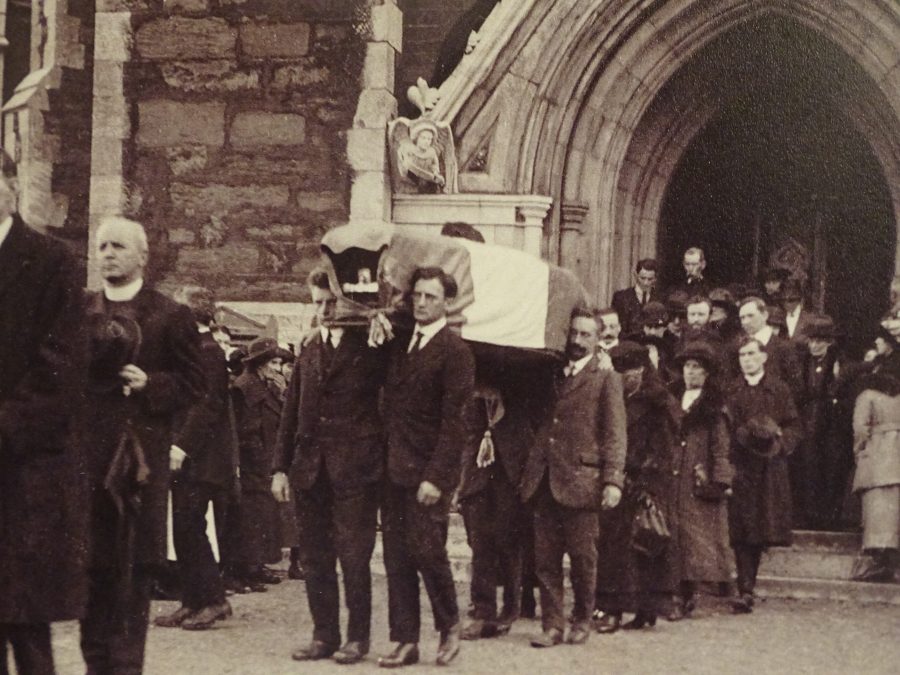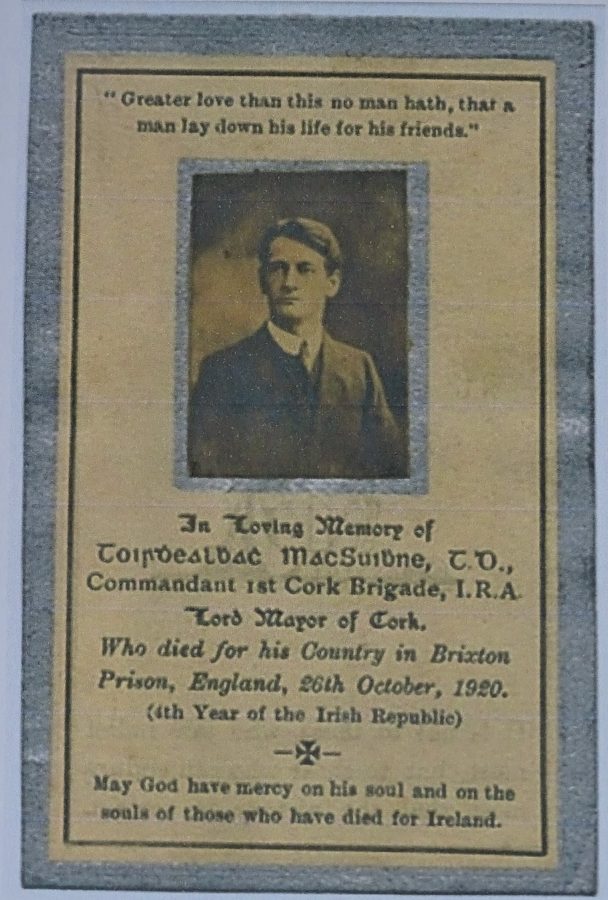
1073a. Coffin of Terence MacSwiney being taken from the North Cathedral, 31 October 1920 (source: Cork Public Museum).
Kieran’s Our City, Our Town Article,
Cork Independent, 5 November 2020
Remembering 1920: Terence MacSwiney’s Funeral
The SS Rathmore ploughed her way across the Irish Sea bringing back to Ireland the coffin containing the Lord Mayor’s body. During Thursday night, 28 October 1920, the mortal remains of Terence MacSwiney returned to Ireland surrounded not by friends, but by British soldiers.
The remains of the Lord Mayor of Cork arrived off Deep Water Quay, Cobh, at 1.45pm on Friday 29 October. The SS Rathmore was met inside the harbour by the Admiralty tug Hellespont. The moment the vessel was sighted, the population of Cobh gathered along the Beach, and when the SS Rathmore reached its berth hundreds of people awaited it. But nobody would take charge of the remains. The people were only complying with the wishes ofthe relatives.
So, the SS Rathmore remained beside the quay – the space full of armed men. These included Black and Tans, London Metropolitan Police, and a strong force of RIC Auxiliaries. They stood grimly on the deck. Soon after deck hands unloosed the ropes around the coffin, which was covered with sail cloth and the coffin and wreaths were transferred to Mary Tavy, an Admiralty tug. The tug, flying a black flag, moved up the river for Cork. Whilst leaving the quays of Cobh, the Bishop asked the crowd to kneel to pray whilst the bells of the Cathedral tolled.
At 4.15pm, the tug arrived at the Custom House Quay. Again, every advantage spot was taken and the crowd densely packed. Again no one chose to receive the body. It was over two hours later that the special train from Dublin conveying the relatives of the deceased Lord Mayor arrived at the Glanmire Terminus, and were driven to City Hall, the wreaths, which accompanied them, being conveyed in the Corporation ambulances. Soon after the auxiliary police removed the body from the tug and placed it on the quay.
At 9.30pm the body was carried into the City Hall on the shoulders of Volunteers, being preceded by clergymen, who recited prayers. Volunteers also preceded the coffin and they carried wreaths. The remains of the Lord Mayor lay in state in City Hall the following day, Saturday 30 October and the ensuing Sunday morning. Notwithstanding the extreme inclement rain a continuous stream of mourners flowed towards the City Hall, where the remains lay in state in a coffin with a glass lid on a catafalque in the large chamber of Cork’s City Hall. A guard of honour of six IRA men was placed standing solemnly to attention around the coffin. These were relieved at two-hour intervals during daylight, but during the night, with curfew in force, they had to remain overnight in the City Hall.
Touching scenes were to be seen as the transfer of the remains from the City Hall to the North Cathedral preparatory to the funeral on 31 October 1920. As early as 8am large crowds packed around the vicinity of City Hall. So large was the crowd that the volunteers had to draw a cordon, which extended from Parnell Bridge to Clontarf Bridge and only those with admission papers were permitted to enter. Major General Strickland had issued a proclamation prohibiting any demonstration or any procession in formation at MacSwiney’s funeral. But the proclamation was ignored.
The coffin was taken from City Hall and was enveloped in the Republican flag. It was shouldered, and on each side marched the Volunteer Guard of Honour. Immediately behind marched the MacSwiney brothers, Peter and Seán, with members of Dáil Éireann such as Arthur Griffith and the Republican Government, senior officers from General Headquarters, IRA, and his colleagues on the Cork Corporation. Heading the Volunteer columns was A-Company, 2nd Battalion – MacSwiney’s own – from University College, Cork.
At the North Cathedral, an enormous assemblage had gathered. The coffin was covered with the Republican Flag once more and Terence’s uniform hat. At midday mass Requiem Mass began led by Bishop Daniel Cohalan and Archbishop of Cashel John Harty and a large number of clergy. Owing to military restrictions, the number of mourners, public bodies had to be strictly curtailed, and Volunteers numbering over 200 tried to keep order in the vicinity of the Cathedral.
After the High Mass, the coffin was shouldered to St Finbarr’s Cemetery by relays of Volunteers, which was followed by relatives, members of Dáil Éireann, corporation bodies, Sinn Féin organisations, University professors wearing Academic robes, Trade and Labour bodies, and other bodies. Each side of the cortege walked Volunteers, each bearing a wreath. Other volunteers were tasked to keep the public on footpaths and to maintain minimum crowds. Other armoured cars and lorries loaded with Black and Tans joined at intervals, flanking the marching IRA men an along the funeral route.
As the Gaol Cross was reached, the salute “eyes left” was given to MacSwiney’s heroic fellow-strikers still in the death throes of hunger in the hospital of Cork’s grim prison a nod to the deaths of Michael Fitzgerald and Joseph Murphy.
At St Finbarr’s Cemetery, Terence’s grave was adjoining that of the late Lord Mayor Tomás MacCurtain and not more than a few yards from the burial spot of Joseph Murphy, the recently deceased hunger striker from Cork Gaol. The final absolution was given by Bishop Cohalan and a short address delivered by Arthur Griffith TD.
The wreaths were then laid on the newly-made grave, and so numerous were these floral tributes that they covered the whole of the Republican Plot. A Volunteer bugler sounded the Last Post and as a final and fitting tribute to the memory to Terence, seven volunteers then fired three rounds from revolvers over the grave. British armour and lorries were still below at the Old Ballincollig Crossroads within sight and sound, but they made no attempt to interfere. The thousands of people who had collected in the vicinity of the graveyard were then permitted to pass in the view the grave and passed out immediately using another gate. People continued to visit the grave until darkness had fallen.
Captions:
1073a. Coffin of Terence MacSwiney being taken from the North Cathedral, 31 October 1920 (source: Cork Public Museum).
1073b. Section from one side of Terence MacSwiney’s memorial card 1920 (source: Cork City Library).

1073b. Section from one side of Terence MacSwiney’s memorial card 1920 (source: Cork City Library).